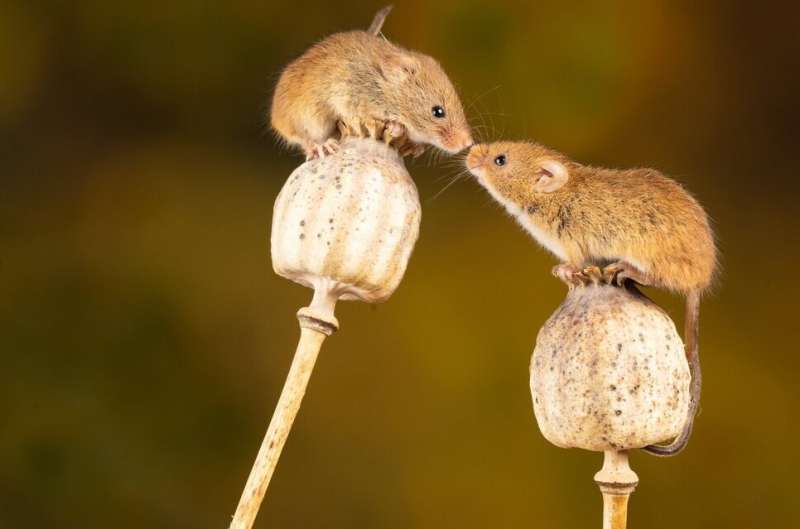This article has been reviewed according to Science X's editorial process and policies. Editors have highlighted the following attributes while ensuring the content's credibility:
fact-checked
peer-reviewed publication
reputable news agency
proofread
Feeling sexy? Scientists find where lust lives—in mice

The source of desire has long been elusive, the stuff of poets and musicians.
Now, Stanford University researchers have found it doesn't live in the heart but in a very specific set of cells in the brain.
They have located the cellular circuitry that drives the passion of male mice, and learned how to turn it on and off—a discovery that could lead to new treatments and deepen our understanding of this most primal force.
"It's a fundamental behavior that is central to our personal satisfaction, and also the propagation of our species," said Nirao Shah, Stanford professor of psychiatry and neurobiology and the senior author of the study published in the most recent issue of the journal Cell.
"But we know very little about how the brain organizes and regulates this behavior," he said.
Shah and his team found buried in mice brains, a bit above the roof of the mouth, tiny neural connections that are tasked with processing information from the outside world.
They tell a male mouse whether another mouse is female, and feeling flirty.
If so, this good news is relayed to an adjacent set of brain cells, located on the same circuit. Then a small protein, called Substance P, issues a call to action—like a Marvin Gaye groove.
Mice aren't men, so it's not known if this mating mechanism will hold true for humans. But because this circuit lives in an evolutionarily ancient part of the brain, it is likely to be universal among male mammals, Shah said.
"It's very likely there are similar sets of neurons that regulate sexual reward, behavior and gratification," he said.
Hormones, such as testosterone, may influence the activation of this system. Females seem to be wired differently, Shah said. That will be the focus of future research.
Scientists have long wondered what drives the yearning to mate. Why are some men promiscuous philanderers, risking divorce and scorn, while others would rather stay home and watch Netflix?
"These new findings extend our understanding of the biological foundations of libido as an initial step in mating and sexuality, with implications for other mammals, including humans," said Justin Garcia, executive director of the Kinsey Institute at Indiana University, a research institute for the study of human sexuality.
In previous research, Shah and his colleagues used several state-of-the-art technologies to meticulously map the neuronal connections that create this circuit.
A neural circuit acts like the wiring of a computer. Different circuits generate different behaviors.
The new project accomplished more than just building a circuitry map. It found that if scientists manipulated the neurons in a part of the amygdala, the seat of our emotions, they could turn on and off a male mice's recognition of the sex of an unfamiliar mouse.
The mice were virgins, to ensure that they weren't influenced by past dalliances.
The team focused on a set of genetically distinct neurons in the amygdala that do something special: They secrete a small and slow-acting peptide dubbed Substance P.
Then the scientists watched a different set of neurons in the preoptic hypothalamus that had receptors for this Substance P. Those two groups of neurons work together, like lock and key.
When Substance P binds to these receptors, it gradually sensitizes the neurons so they become increasingly active.
"It tells them that this is a potential mate, and 'you can now start thinking about starting to mate with them,' " Shah said.
Normally, male mice are slow to warm up, taking 10 to 15 minutes before mounting. Afterwards, they take a five-day break before regaining interest.
But when the researchers directly infused Substance P into mice brains, the animals turned into love junkies.
Rather than waiting to mate, the mice were ready instantaneously. They even fell in love with lab equipment, mounting plastic tubes adorned with the tail end of a toy mouse bought on Amazon.
They could also become prim, proper and prudish. When researchers silenced the neurons and switched off the circuit, dialing down production of Substance P, the mice lost desire.
This neural circuit also appears to regulate the pleasure that is associated with sex, Shah said.
The findings could be used to help expand the populations of endangered species, which are often reluctant to mate in captivity, said Shah.
"The ability to sort of switch the circuit off and on is profoundly powerful," he said.
The study's findings also could lead to human drugs that regulate these circuits. They would be quite different from existing drugs, like Viagra, that enhance blood flow to counter erectile dysfunction, Shah said. Instead, they would act like rheostats—inhibiting the urge in men with hypersexual libidos or boosting it in those who lack lust.
For the findings to have biomedical usefulness, he said, Substance P must first be found in similar neurons in humans.
"Now we know where to look for it," he said, "and what to look for."
More information: Daniel W. Bayless et al, A neural circuit for male sexual behavior and reward, Cell (2023). DOI: 10.1016/j.cell.2023.07.021
2023 MediaNews Group, Inc.
Distributed by Tribune Content Agency, LLC.




















